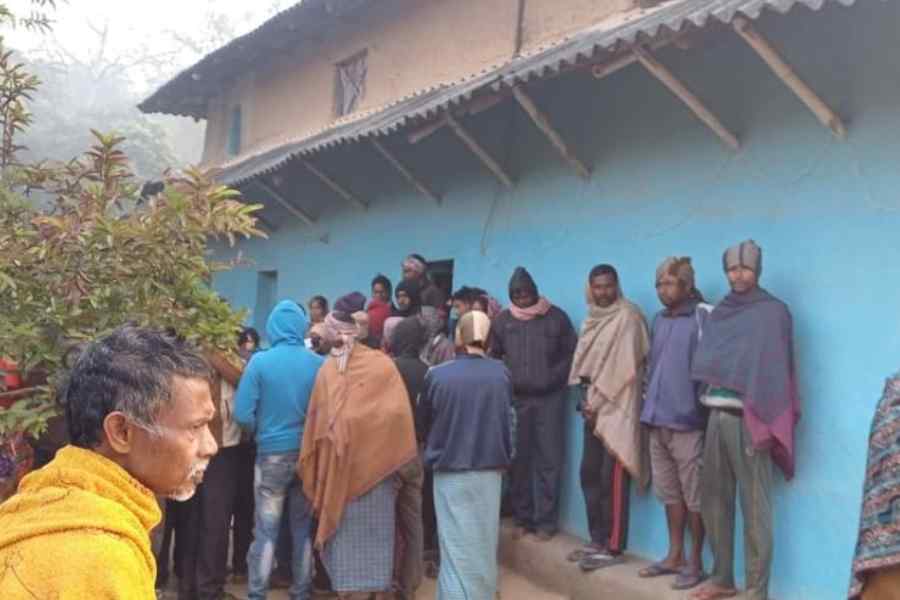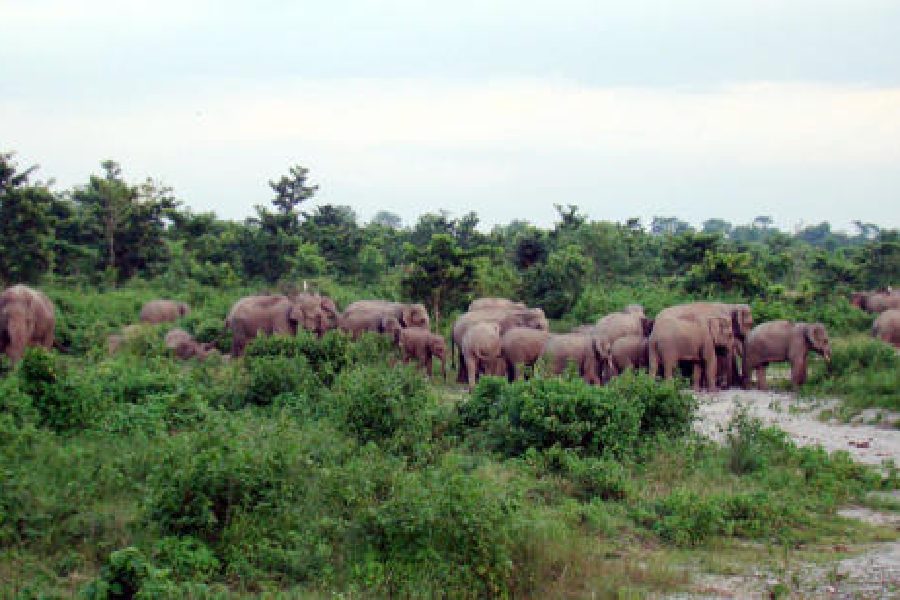A wild elephant that got separated from its herd barged into a two-storied mud house in Jhargram, dragged out a sleeping 70-year-old woman and trampled her to death in the courtyard in the early hours of Friday.
Kokila Mahato’s death in Dhekipura village, 11km from Jhargram town, could be the outcome of human-elephant conflict caused by paucity of food, a senior forester said. The elephant appeared to have killed the woman in frustration after failing to find food.
“Elephants usually break into houses to get food, like stored paddy, rice, and sometimes even hooch. We have many instances of human deaths on account of the
collapse of mud walls on them, following an attack by an elephant. But they
usually don’t kill people intentionally, dragging them out of their homes,” the forester said.
A group of villagers protested before the foresters and police for around an hour, and were promised round-the-clock vigil to ensure no elephant enters the village.
“If elephants start dragging us out of our homes and killing us brutally, what can we do? We urged the forest officials to ensure that no elephant is able to raid our village after this,” said Prabir Mahato, a villager.
According to Praffulla Mahato, the elder son of the victim, the elephant first broke a window and looked for something inside, with its trunk. Around 3am, it went on a rampage.
“After failing to take anything out through the window, it broke down the door and took out my mother, as she was sleeping on the floor. We woke up to the noise of the door being broken. We had no time to rescue my mother as she was trampled within two minutes,” he said.
A villager said an elephant had rammed into the same house last year and grabbed two bags of paddy.
A forester, working for at least five years in the elephant zone of the Jungle Mahal, said the same elephant could have raided the house again, remembering it as a source of food.
“Elephants are very intelligent animals, and their memory is outstanding. It could be that he killed the woman out of anger, after failing to get some food from a place it found food in previously. Elephants always keep visiting the same place, if they find food or water there once,” said the forester.
Currently, the Jhargram forest division has 29 elephants, including six-seven loners. The area is one of the vulnerable zones of human-animal conflict in south Bengal. In 2022-23, 26 people were killed in Jhargram in elephant attacks. A forester said the number in the current fiscal is around 15.
According to a source in the forest department, winter is the toughest time to handle elephants because of a lack of adequate food sources in the region after harvesting is over.
There are very poor sources of natural food inside the forest, in the four Jungle Mahal districts -- Jhargram, Purulia, Bankura, and West Midnapore -- which do not have trees like bananas, jackfruit, or bamboo, which elephants usually eat.
“There is no food for elephants here. Elephants don’t raid houses when there is paddy or vegetables in the fields. As harvesting is done, there is nothing in the fields, as vegetable cultivation is sparse in the region. This time is very tough for us to manage the human-elephant conflict, as the animals raid houses for food. But we are concerned about the security of people inside the homes, after this incident,” said a forest official.
Three years ago, the forest department in Bengal took the initiative to plant fruit trees in all of its divisions that house elephants.
“We annually conduct plantation drives in 5,000 hectares of land. Over the past three years, we have reserved a 20 per cent area for fruit tree plantation.
“But as the trees grow slowly, it will take some time to ensure food sources inside the forests in south Bengal,” said Debal Ray, the chief wildlife warden of Bengal.
“For this incident, we have to find the reasons why the elephant dragged out the woman and killed her. We are probing it,” he added.
Those who conduct regular research on human-elephant conflicts said the problem was the result of the absence of a free and proper habitat for elephants.
“If a village is located adjacent to the forest, it might fall under the forage areas of elephants. I have already talked to top forest officials about my proposals, that the government has to ensure a proper elephant habitat and natural sources of food.
“Elephants never raid houses if there are sources of food inside the forest. It is not elephants but the villagers, who have to understand this first,” said Nilanjana Das Chatterjee, a teacher of Geography at the Vidyasagar University, and a researcher on human-elephant conflict.
In another development, a 55-year-old woman was killed by an elephant in the Nagrakata area of Jalpaiguri, while she was grazing cows in a field on Friday morning. Tara Tamang, 55, was killed when a wild elephant came out of the Dayna forest and chased her. She was killed by the animal, after failing to outrun it.











